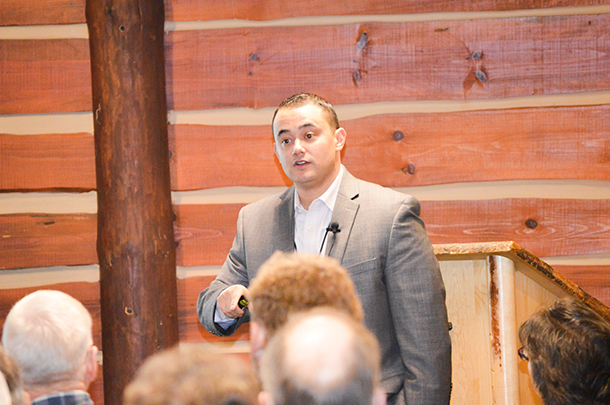Keeping up to date and staying in-the-know is important for all dairy farmers, especially in challenging times of milk prices. John Newton, senior director of economic research at the National Milk Producers Federation (NMPF), shared a brief snapshot of what the markets did in 2015, as well as what might help protect prices in 2016 during his workshop presentation at FarmFirst Dairy Cooperative’s annual meeting, which took place Feb. 12-13 in Onalaska, Wisconsin.
 2015 was certainly a challenging year for dairy farmers. Milk production in the U.S. was up 1.2 percent to a record 208.5 billion pounds, while milk prices declined by more than 30 percent from their 2014 highs. While prices in the upper Midwest declined relative to 2014, average mailbox prices in this area remain $.20 to $.80 per hundredweight above the national average.
2015 was certainly a challenging year for dairy farmers. Milk production in the U.S. was up 1.2 percent to a record 208.5 billion pounds, while milk prices declined by more than 30 percent from their 2014 highs. While prices in the upper Midwest declined relative to 2014, average mailbox prices in this area remain $.20 to $.80 per hundredweight above the national average.
“Thus far, 2016 is proving to be equally challenging, as USDA is currently projecting U.S. milk production to increase by another 1.6 percent year-over-year with an average all-milk price of $15.30 to $16 per hundredweight,” said Newton.
However, there have been declines in value throughout agriculture commodities over the past 12 months. Crude oil is down 40 percent; pork is down 36 percent; beef is down 30 percent; and the overall commodity price index is down 16 percent.
“Yet, firm domestic consumption of milk fats helped to keep U.S. milk prices higher than prices received in New Zealand and the EU,” added Newton. “Prior to 2015, the average contribution of fat to the Class III milk price was approximately 40 percent. During the past year, due in large part to the record-high butter prices in 2015, fat represented nearly 52 percent of the Class III milk value.”
Newton also shared a few factors that are helping support U.S. dairy market prices, including the CWT (Cooperative Working Together) program.
“In order to help expedite the recovery of U.S. milk prices, the CWT program provides export assistance to move product offshores to international buyers. Since 2010, the CWT program has provided assistance to 826 million pounds of cheese, butter and whole milk powder,” said Newton.
In addition, NMPF is engaged in a number of policy issues to help improve the consumption of dairy and milk products produced by U.S. dairy farmers, including the Child Nutrition Reauthorization.
“We’ve worked to include provisions that will return 1 percent flavored milk and 14-ounce milk containers to schools. We’re pushing back on overly restrictive standards by highlighting the science of milk's nutritional value and reverse the trend regarding restrictions on milk fat,” commented Newton.
While championing dairy within the U.S., NMPF worked with the U.S. trade representatives to prevent the Trans-Pacific Partnership (TPP) from being a one-sided trade agreement.
“NMPF is still conducting the economic analysis on TPP, but by far the biggest win for U.S. dairy farmers was in preventing full access to our markets to New Zealand,” said Newton.
“As we work through challenging times, we will continue to engage with farmers on ways to improve milk pricing and farm safety net programs,” said Newton. “We are reviewing ongoing issues in the Federal Milk Marketing Orders [FMMO] and actively working to make the Margin Protection Program [MPP] a more effective safety net.”
To stay up to date with timely dairy market information, visit NMPF’s "milk pricing and economics" website. The new website includes up-to-date interactive charts featuring key indicators of dairy price and marketing conditions. PD
Julie Martin is the director of communications and marketing for FarmFirst Dairy Cooperative.
PHOTO 1: According to John Newton, senior director of economic research at the National Milk Producers Federation (NMPF), the Cooperatives Working Together (CWT) program is hard at work moving dairy products like cheese, butter and whole milk powder off shores to international buyers in an effort to expedite recovery of the domestic milk price. Staff photo.
PHOTO 2: John Newton from the National Milk Producers Federation (NMPF) discussed the challenges and opportunities for dairy prices in 2016. Photo provided by FarmFirst Dairy Cooperative.



